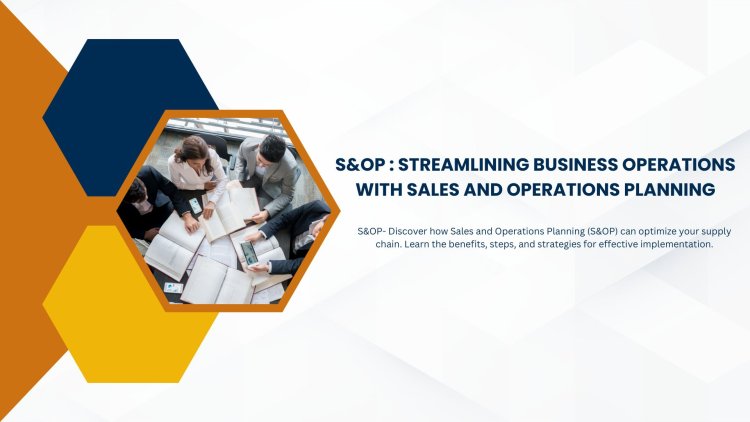S&OP : Streamlining Business Operations with Sales and Operations Planning
S&OP- Discover how Sales and Operations Planning (S&OP) can optimize your supply chain. Learn the benefits, steps, and strategies for effective implementation.
Share this Post to earn Money ( Upto ₹100 per 1000 Views )

In the fast-paced and competitive business landscape of today, Sales and Operations Planning (SOP) has emerged as a crucial strategy for organisations seeking to optimize their operations, enhance efficiency, and achieve alignment between various departments. In this comprehensive article, we delve deep into the world of SOP, exploring its significance, benefits, implementation process, and how it plays a pivotal role in streamlining business operations.
Understanding Sales and Operations Planning (SOP)
At its core, SOP is a cross-functional process that brings together key stakeholders from sales, operations, finance, and other relevant departments to collaboratively develop a unified operational plan. This plan outlines how the organisation will allocate its resources, meet customer demand, manage inventory levels, and address potential challenges. By harmonizing demand forecasts, production capacities, and inventory levels, SOP aims to achieve a delicate balance between customer satisfaction, operational efficiency, and financial objectives.
The Significance of SOP
SOP is not merely a tactical process; it serves as a strategic compass that guides the organisation towards its long-term goals. Some of the key reasons why SOP holds immense significance are:
-
Demand-Supply Alignment: By synchronizing demand forecasts with production capabilities, SOP minimizes the risk of overstocking or stockouts, ensuring a steady supply to meet customer demands.
-
Enhanced Visibility: SOP provides a holistic view of the organisation's operations, enabling informed decision-making by considering the interdependencies between departments.
-
Resource Optimization: By allocating resources optimally based on accurate demand forecasts, businesses can avoid unnecessary costs and maximise their operational efficiency.
-
Risk Mitigation: SOP allows organisations to proactively identify and address potential challenges in the supply chain, reducing the impact of disruptions.
The Benefits of SOP Implementation
The advantages of implementing SOP are multifaceted and impactful:
-
Improved Forecasting Accuracy: SOP's collaborative approach enhances forecasting accuracy by incorporating inputs from various departments, resulting in more reliable predictions.
-
Reduced Costs: Effective demand and supply planning help organisations reduce excess inventory, storage costs, and costly last-minute production adjustments.
-
Enhanced Customer Service: By consistently meeting customer demands and avoiding stockouts, SOP contributes to higher customer satisfaction and loyalty.
-
Better Decision-Making: With data-driven insights and cross-functional collaboration, SOP enables informed decision-making at all levels of the organisation.
-
Strategic Alignment: SOP aligns operational plans with the broader strategic goals of the organisation, fostering a clear roadmap for growth.
Implementing SOP: The Process
-
Data Collection and Analysis: Gather historical sales data, market trends, and other relevant information to create a solid foundation for the planning process.
-
Demand Forecasting: Collaborate with sales and marketing teams to create accurate demand forecasts based on market trends, historical data, and upcoming promotions.
-
Supply Planning: Assess production capabilities, supplier capacities, and inventory levels to ensure the organisation can meet the projected demand.
-
Balancing Demand and Supply: Bring together the demand and supply plans to identify gaps, mismatches, and potential issues that need to be resolved.
-
Scenario Planning: Anticipate various scenarios, such as changes in demand or supply disruptions, and create contingency plans to address these situations.
-
Executive Review and Approval: Present the SOP plan to the executive team for review and approval, ensuring alignment with strategic objectives.
-
Execution and Monitoring: Put the plan into action and continuously monitor performance against the established metrics. Adjust the plan as needed to ensure success.
Embracing SOP for Operational Excellence
In conclusion, Sales and Operations Planning is not just a buzzword; it's a transformative strategy that enables organisations to thrive in a complex business environment. By aligning sales forecasts with operational capabilities, SOP empowers businesses to make informed decisions, optimize resources, and deliver exceptional customer experiences. As markets evolve and competition intensifies, adopting SOP becomes a strategic imperative for organisations seeking to achieve operational excellence and sustainable growth.
Visit:- https://deflytics.com/sop-sales-and-operations-planning/














